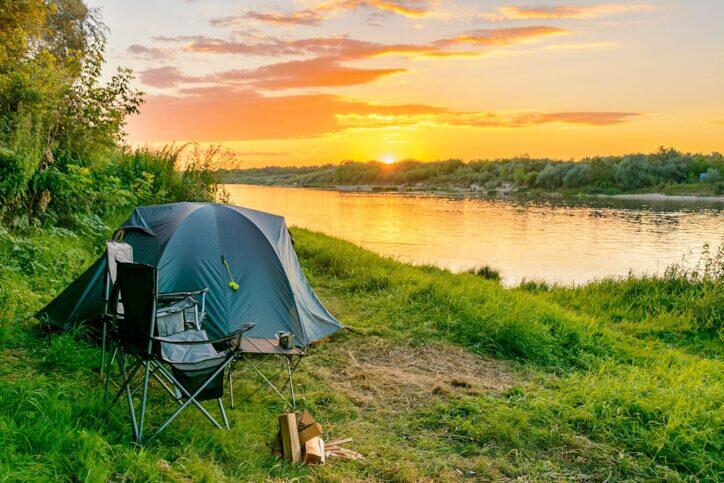Here's how to make summer camping less sweaty.
If you’re like many outdoor enthusiasts, summer is the time to unfurl our tents and look forward to nights under clear skies and the smell of the campfire. But summer also means higher temperatures and being overall uncomfortable in our hotbox tents. This is especially true if you plan a backpacking trip where you are also required to physically exert yourself before you even make it to your campsite.
However, there are some ways that you can make it easier to handle the heat on your outdoor adventures. This does require some additional preparation and the possibility of changing up your current gear system, but it’s well worth it to avoid the discomfort of being overheated–and the dangers that come with that, as well.
Here are some recommended ways to stay cooler on your camping trip and items that can help you spend less time sweating and more time enjoying your time in nature.
Clothing
Finding that balance between staying covered enough that you aren’t sunburned but not overheated is the fine line we all want to find in the summer heat. The trick is to look into fabrics that wick sweat rather than absorb it, and that are lightweight on top of it.
This means looking into ditching those cotton tees. While they tend to be cool most of the time, if you are sweating then you will start to notice a foul stench within a few hours of spending time outside in the hot weather. Depending on how long you plan on spending away from a clean set of clothes, this can get old very quickly.
Recommended Fodor’s Video
Instead, look into other types of fabrics like an ultralight Merino wool t-shirt or a breathable synthetic like polyester or nylon. This will keep the sweat from sticking to your body and even causing you to become overheated after a while. Choose the same for sweatshirts for the cooler evenings.
For overnight camping trips, shorts might not be the answer. While they can keep you cooler while you are active, they also leave you more exposed to the bugs that like to make an appearance during the summer months. You might want to consider lightweight pants as an alternative, since not only will these protect your legs from brush and bugs, but you also won’t feel too hot in them when resting at your campsite.
For backpackers making the trek to their accommodations, finding boots without waterproof membranes can help you to avoid swampy feet. While you might keep them on your gear list if your chosen route includes water crossings, lightweight, breathable boots with ventilation will be a godsend on long trails under the summer sun.
Likewise, your choice in socks is even more important since a sweaty foot means you have a much higher chance of blisters. Merino wool socks are usually the way to go, though they can be a bit more expensive than synthetic options. Whatever you choose, avoid cotton and make sure it is lightweight.
To avoid that sun on your face, consider a breathable cap and buff. A buff can be one of your best tools in scorching temps since you can dip it in cool water and place it on spots that tend to warm up fast like your head and neck.
Tent and Camp Setup
Of course, the type of camping setup you have will have a big influence over how cool you stay. While a three-season tent is the most common choice for a night outside, it isn’t necessarily suited well for extreme weather conditions–whether it’s sweltering heat or the winter chill.
You might have to get a bit creative with your shelter, and that doesn’t mean that you have to go out and buy a brand-new tent. A simple tarp strung between trees can protect you from rainfall while also giving you that ventilation you need to stay cool overnight. Backpackers can also rejoice with this simplified setup since it’s much more lightweight than an entire tent.
If you can’t stand the thought of not having a bit more structure, then make sure your tent has ventilation and a removable rain fly. Also consider tent fabrics if you haven’t made a purchase yet. Most tents are made of either polyester or nylon. While polyester lets in fewer UV rays, it is heavier and might be less breathable. Nylon is typically a better choice during the heat of summer because it is lighter and overall tends to be cheaper to buy.
What you sleep in can be the differentiating factor between an incredible adventure and one where you sweat more than enjoy. Like choosing a tent with lightweight fibers, you’re going to want to do the same for your sleeping bag. For this piece of gear, polyester fleece tends to be the way to go since the insulation is light. However, if you predict temps dropping below 60 degrees at night, then this won’t be heavy enough.
Where you place your tent can also affect the enjoyment of your trip. Choose a place where you can get some wind coming through, but in a location where you are also not directly exposed in case of a summer lightning storm. Placing your tent door into the breeze can also increase ventilation, and shade is always a good idea when dealing with warm weather.

Food and Drinks
You’ll want to minimize how much heat you put out when you are camping in extreme heat. Look into packing lunches that you can keep in a cooler and that you can prepare beforehand. Premade meals can limit the amount of energy you spend, as well, which will make your body less sweaty and fatigued.
On the other hand, this also means that you will need to do quite a bit of prep work before you head out on your camping trip. Freeze meats and other items beforehand, and let them thaw out when at the campsite. You’ll also want to use blocks of ice or freezer packs if available rather than ice cubes, which melt faster. You can take a large gallon jug and freeze it before packing your cooler, which can also serve as an extra water source.
Another piece of advice is to keep drinks separate from your food in another cooler. You’re likely to be opening this cooler more often to access water and other ways to hydrate, and the fewer times you open a cooler, the more likely it will stay cold. If you plan on having an alcoholic beverage, then you will want to make sure that you have extra water and drinks with electrolytes so you can rehydrate faster. Likewise, if you are taking on an activity where you know you will be sweating a lot, you will also need more water.
Tech
Having a little help from the newest outdoor gadgets can also make your time in the heat bearable. By choosing lightweight items and doing a bit of research into the newest and best gear, you can end up saving sweat.
One item that comes highly recommended is a solar camping stove rather than traditional charcoal or propane option. These emit a lot of heat, which is the last thing you want to experience when you are already roasting. The solar stoves also tend to be pretty light so if you are planning on hiking a good way then you also don’t need canisters and charcoal on your back.
Likewise, solar-powered phone chargers are always a great idea since you might as well take advantage of the warm weather and baking rays. If your phone is also your way of getting in touch with others in case of emergency, then you’ll want to make sure that you have a way to keep it powered on.
Dogs
There’s nothing better than hiking and camping with your pup, and many of the concerns that you have about being outdoors in the heat should be considered for them too. Shade should be an essential feature of the campsite since dogs can’t sweat and will need natural areas to cool down.
You’ll also need to pack just as much water as you yourself plan to use on your camping trip. Dog’s fur often traps heat. Drinking water or using the same trick of wrapping a wet bandana around their neck can go a long way toward cooling them off.
Of course, there is also a bunch of tech for your pet to keep them from getting overheated as well. A cooling bed can be a great item to bring on a car camping trip, while a pop-up shelter or cot to help them get off the ground can be helpful too. Hiking booties can protect sensitive paws, and dogs with lighter-colored fur might need sunscreen on areas likely to be burned.
Just because the weather heats up doesn’t mean that you shouldn’t be able to get out and camp. With some preparation and the right gear, you can avoid the sweltering heat and make the most of your summer outdoors.





